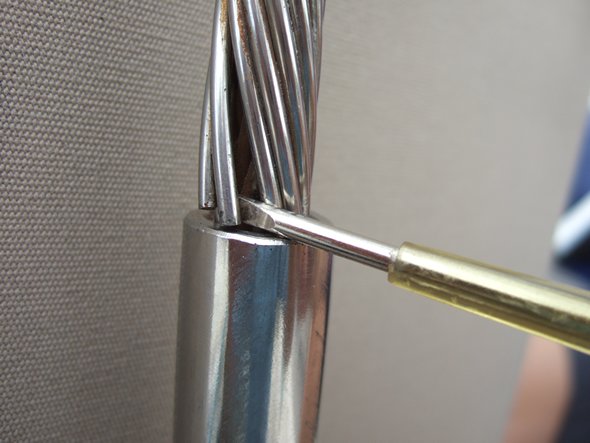Rig Failure - Perhaps it was rougher than we thought!

Aurora_b
Mike and Liz Downing
Tue 29 Oct 2013 09:42
|
We always check our rigging before going to sea on a
long passage. The importance of doing so was brought home to us again this
week when Jacaranda, the boat we sailed with from Cocos Keeling,
found two shrouds with broken wire strands. For those technical it was the
aft lowers; for those not, the rigging is made of 19 strand wire called
shrouds and a weak point is where the wire comes out of the
fittings (called swages) at either end. So it was time to check our rigging
and we were shocked to find broken strands in 3 shrouds. Even worse,
it included the strongest, 12mm, lower cap shrouds - both sides
(one had 3 broken strands and the other one). The 3rd to go was one of the
smaller 8mm intermediates. So we needed to replace the 2 lower cap shrouds
and both the intermediates (if one goes the recommendation is that you
replace both). Our rigging was completely replaced in 2007, so should have
been good for 10 years, even considering the mileage we're doing. We had it
professionally checked in Sydney before we left and I checked it in
Darwin. Jacaranda's rigging was only 2 years old. Of the dozen or so boats that
we've met that have made the crossing, no other has reported rig failure. So is
it just a coincidence, or was it the periods of rough weather, that
being relatively close, we both sailed through. The seas were very
confused at times and big, so when we rolled, it was a significant roll and the
forces on the rig must have been huge. However, it's built to stand up to these
forces and shouldn't have broken.
Although the wire has 19 strands and only 1 or 3
strands had broken, if one goes today the others could easily go tomorrow, so
the recommendations is to replace the shroud as soon as a broken strand is
found. Now that's not so easy in Mauritius where they have very few resident
yachts. With 12mm wire it's impossible as there is no 12mm wire on the island.
Reunion, the French island next door (100 miles to the southwest) has
many resident yachts and is well supported with yachting services, but, as
we discovered, no 12mm wire. So we were snookered and started thinking how we
might support the mast with strong rope (dyneema/spectra). We also thought we
should discuss the options with our insurance company, to make sure we would
still be insured. Now that was a really good idea. We called them last
Wednesday and found that one of their reps was flying to Mauritius on Friday in
order to meet yachts taking part in the Oyster Round the World Rally that's
due to arrive this week (Oysters being very big and expensive yachts).
Within sight of the insurers offices in Plymouth is a yacht rigging shop. So the
insurance company made contact with the rigging shop and arrangements were
made for me to specify what we needed so the rigging shop could make it
up in time for the insurance rep to bring it on Friday, as
personal baggage. It sounded too good to be true, but wasn't. We met the plane
which arrived at 08.00 on Saturday, brought the rigging back to the boat
(having hired a car) and the rigger we had arranged arrived at 13.00 to
start fitting it all. It took 5 hours, but by 18.00 we had the faulty shrouds
replaced and the rig was ready to go. So just 3 days from the initial call to
the insurers - not at all bad! The cost, however, was bad - very
close to £2,000 when including the rigger's cost.
The rigger was an interesting guy. We didn't expect to
find one here as there are few resident yachts, and certainly not one with
good experience. However, we were lucky. He's taken part in several Vendee Globe
races (single-handed non-stop round the World race), coming 3rd one year, and
Transat races (double handed across the Atlantic) and won. So he certainly
knows how to sail and did some good rigging work on other boats. The
one slight problem was that he's very French. Not a problem in itself I hasten
to add, but he speaks very little English (about as much as I
speak French!) which made working as rigger's mate, which I did for 5
hours, a little tricky at times. In addition to rigging he teaches the
children here how to sail and also provides routing advice for
ocean sailors, amongst other things.
 Wires that have snapped where they enter the
swage terminal. This is 12mm and, everyone says,
stronger than is needed (most boats of our
size would have 10mm wire), so we were very
surprised.
To try and ensure the replacement shrouds last
longer, we have opted for dyform which is supposed to be 30% stronger than
normal rigging wire. It's also 30% more expensive! (Our working forestay
and cutter stay are also dyform - 10mm and 8mm.) 12mm dyform should be
well over spec. Lets hope it is this time!
|